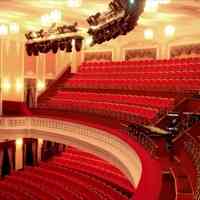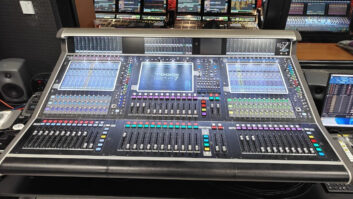
While wired systems are still in demand in the theatre industry, digital wireless intercoms are beginning to take centre stage as affordable, robust systems enter the market. Phil Ward reports
In conversation a couple of PLASAs ago, Adrian Richmond of RTS Intercoms UK described intercoms as “the Cinderella of the pro-audio industry”. Few would have disagreed, but since then there’s been something of a quiet revolution going on.
Like everyone else in this field, Richmond’s company has been responding to the spectrum squeeze. Narrow-band units are now appearing that use as little as 25% of the bandwidth of earlier systems, while maintaining very high audio quality. But more than anything else, the digital matrix has come of age in all kinds of installation circles.
“We have expertise in matrix communications, and we used PLASA to get it across to consultants that it provides the ability to target communications, rather than just using loops,” Richmond recounts. “Once contractors get on board with the whole concept, it’s of great benefit to theatre, live sound and lots of other applications. People use a computer-controlled mixing desk. Why not use a computer-controlled communications system?
“Once you get to that stage, you make the end user’s life a lot easier because you set up very complicated systems very simply, allowing them to do their job faster. Our intercoms are now colour-coded and wireless, so they extend into the wireless world of remote control and monitoring. For example, a matrix system could tie up with the paging system within a theatre, while also doing production prompts backstage and connecting with a wireless system to take it around dressing rooms. So you could have artist call, public address and production prompts all controlled from the same centre, giving stage managers an extremely powerful tool to do their job.”
@page_break@
Grease is the word
Indeed, theatres are among the chief beneficiaries of the digital matrix intercom, and all of the market leaders are finding success in the world of greasepaint and names in lights. The RTS family of digital intercom matrices is extensive, ranging from the top-of-the-range ADAM matrix, available in sizes from eight to over 1,000 users, to the original Zeus 24-port matrix. Just recently this line was overhauled: at InfoComm 2010 in Las Vegas RTS Intercom Systems launched the Zeus III Digital Intercom Matrix, which supersedes the previous generations of Zeus and Zeus II matrix frames.
Netherlands-based ASL Intercom BV has also latterly added both wired and wireless digital systems, offering respectively full duplex digital communication between up to 240 user stations and full duplex digital transmission in the 2.4GHz frequency band.
“We wanted to design a system that is easy to set up and to operate,” explains Eric de Bruyn, managing director of ASL, of the new digital series. “Theatres, for example, appreciate that many different configurations can be stored and that switching from one configuration to the other is fast and simple. Operating the system does not require special knowledge or training. The configuration software and the controls on user stations are self-explanatory.”
ASL’s Advanced Intercom Matrixing is a proprietary protocol and the core technology of ASL Digital, said to help these intercom systems to be easy to design and install. Once in operation, ASL’s ConfigurIT software is used to adapt the system for particular applications, as well as to create and store multiple presets for different event types or productions in rotation. An ASL digital system consists of matrix units, user stations and interface modules, and a variety of accessories such as hubs and wall boxes.
The wireless system is based on 2.4GHz and is designed for short- to medium-range applications. There are 2- and 4-channel base stations; a maximum of eight 1- or 2-channel beltpacks can be used in one location, in which case either two 4-channel base stations or four 2-channel base stations have to be linked.
“It was important to us that the intelligibility of the system would match our wired systems,” adds de Bruyn. “If people have to wear their headset for a long period of time it becomes very tiring to listen to something like telephone quality.”
Swiss manufacturer Ateïs is now on its second generation of fully programmable DSP audio matrix, called the UAPG2. This generation increases the sampling rate to 96KHz and uses a SHARC 32-bit, 266MHz DSP processor. Teleconferencing is possible for up to 16 people per unit, while a total of 12 units can be linked together.
According to Neil Voce, director of Ateïs UK, the UAPG2 audio matrix dramatically increases functionality and value for money. “For less than £1,000 you have paging, full DSP, routing matrix, message scheduler and storage, and so much flexibility,” he says. “It gives the client so many more facilities within a box that’s simple to understand.”
The availability of cheaper yet more effective DSP is at the heart of a trend, Voce believes, that will benefit everyone – not just theatre hands. “It puts lots of facilities in the palm of your hand, to build the system you want,” he says. “The market of discrete components is shrinking as the all-in-one boxes take over. And the automation takes away the issue of user interference. It’s a way that the quality of pro audio can enter the non-pro marketplace, and theatre comms is just one example.”
@page_break@
Wireless world
“We’ve talked to hundreds of operators at several ABTT and PLASA exhibitions and it’s given us a good idea of what the majority of the customers want,” declares Mike Reay, Canford Audio’s exhibition co-ordinator. “This can be condensed to the following: full duplex operation; good coverage; intelligibility; being simple to use; and being affordable – budgets are very tight. Accordingly we’ve made great efforts to provide an affordable wireless system that’s physically robust, offers decent coverage and will ensure operators won’t miss a cue.”
That system is Tecpro Wireless. Recently, Glasgow-based Warehouse Sound Services sold a system to the Pitlochry Festival Theatre. Tecpro can be used as a standalone system or interfaced to the Tecpro wired ring. When used with interface up to five beltpacks can operate in full duplex mode.
“While wired communications remain very popular due to their general affordability, reliability and decent audio quality,” Reay continues, “they have clear disadvantages when operators are climbing ladders, clambering over gantries, performing complex scene changes or moving around in public areas. Wireless communications offer a practical solution.
“Simple walkie-talkie interfaces have been around for a long time and provide intelligible simple communication with the wired comms system. Providing operators show a degree of discipline, they are a cost-effective solution. However, as events become more complex, full duplex operation is being asked for more and more.”
California-based Clear-Com runs the full gamut of wireless, matrix and IP-addressable intercoms, with IP providing a truly global dimension to the intercom reach. “That’s the big picture,” comments north-east US regional sales manager James Schaller, “but within the theatre market it’s all about wireless – especially following the reduction of UHF bandwidth. Taking this into account we’ve developed FreeSpeak, a satellite-antenna system with automatic roaming, and more recently Tempest – which actually requires no frequency co-ordination. It’s beyond the UHF range at 2.4GHz, and uses FHSS [Frequency Hopping Spread Spectrum] technology at a rate of 200 times per second.”
Tempest has four intercom channels and comes with five beltpacks and remote antennas. It is undoubtedly leading Clear-Com into emerging digital, wireless intercom territory.
At London-based full-service pro-audio company Orbital Sound, the UK distributor of the HME brand of professional wireless products, MD Chris Headlam acknowledges that West End and touring theatre shows are increasingly utilising the fully duplex radio comms that enable all parties to talk and listen at the same time. “Highly popular,” he points out, “is the DX range from HME that features 2.4GHz, licence-free operation and a mixture of radio beltpacks, radio headsets and radio loudspeaker outstations.”
These can interface with conventional wired comms but, says Headlam, increasingly Orbital is seeing wireless-only systems in theatres. “They offer very quick set-up time and great reliability,” he says. “The advent of the WS200 wireless speaker station has opened up a whole new host of theatrical applications, like production desks in rehearsal periods and integrated backstage paging without wires. In 99% of applications the range of digital wireless comms is proven to be more than enough for the venue’s needs, and because the HME system operates at 2.4GHz it’s well outside the frequency bands affected by Ofcom’s digital switchover.”
@page_break@
Switchover concerns
Headlam adds a note of warning regarding bandwidth, a subject many installers may think they’ve escaped if their footprint is more offstage than on. “Many analogue systems will require re-tuning away from the spectrum lost in the 2012 switchover,” he says, “and whether or not this is possible is down to the specific manufacturer. Looking forward, the reduced spectrum that will be available to us makes digital systems look a whole lot more practical, especially for touring applications.”
HME’s DX range also uses FHSS technology, providing interference-free operation for up to 15 mobile users per base. The lightweight beltpacks and all-in-one headsets operate for up to 20 hours on a rechargeable lithium-ion battery, while an interface is provided for two- and four-wire intercom systems. ISO function allows mobile users to make stage announcements or communicate on a private channel.
The new WS200 wireless speaker station eliminates costly and time-consuming hardwiring, and can be placed anywhere. “We designed the WS200 with the convenience of the professional user in mind,” says Rick Molina, product manager of HME’s pro-audio division. “No longer will they have to run new cables to accommodate a different production or show – they just grab the unit and move it wherever they need to go. We know some users can’t or don’t want to wear a headset for extended periods of time, so the WS200 is the perfect solution.”
HME’s WS200 is claimed to be the only wireless speaker station designed for two-way intercom communication. It features a built-in speaker, built-in microphone, visual and audible call signalling and a headset jack. Intended for use with a DX200 or DX100 base station, the WS200 takes the place of a beltpack or an all-in-one wireless headset communicator.
Eventually, such sophisticated matrices shall go to the ball. As theatres adopt routing and networking options provided by the console market leaders such as Lawo, DiGiCo, Soundcraft Studer and Stagetec, the slipper of intercom will fit pro audio’s most elegant of footprints.
www.asl-inter.com
www.ateis-international.com
www.canford.co.uk
www.clearcom.com
www.hme.com
www.orbitalsound.co.uk
www.rtsintercoms.com







